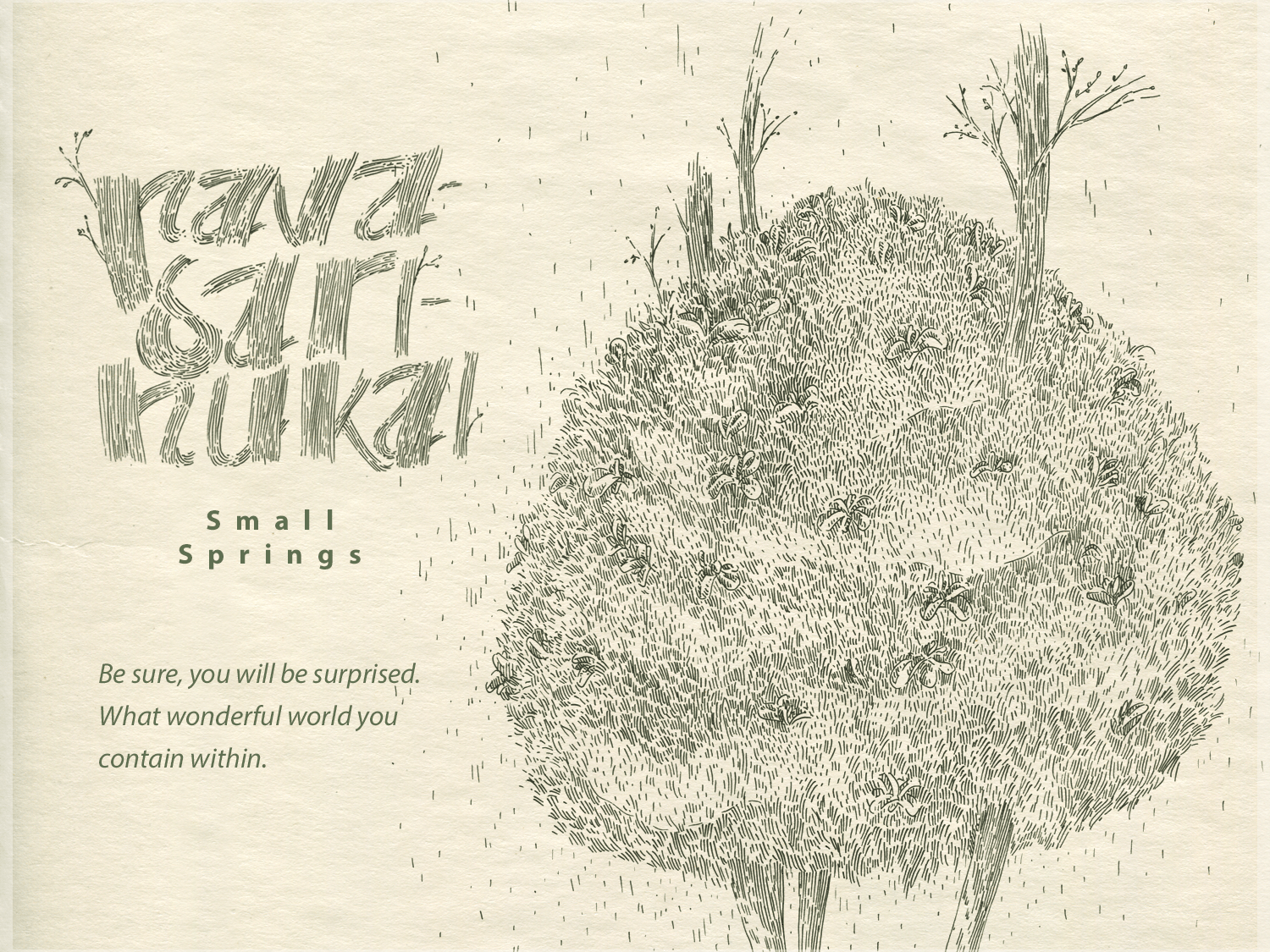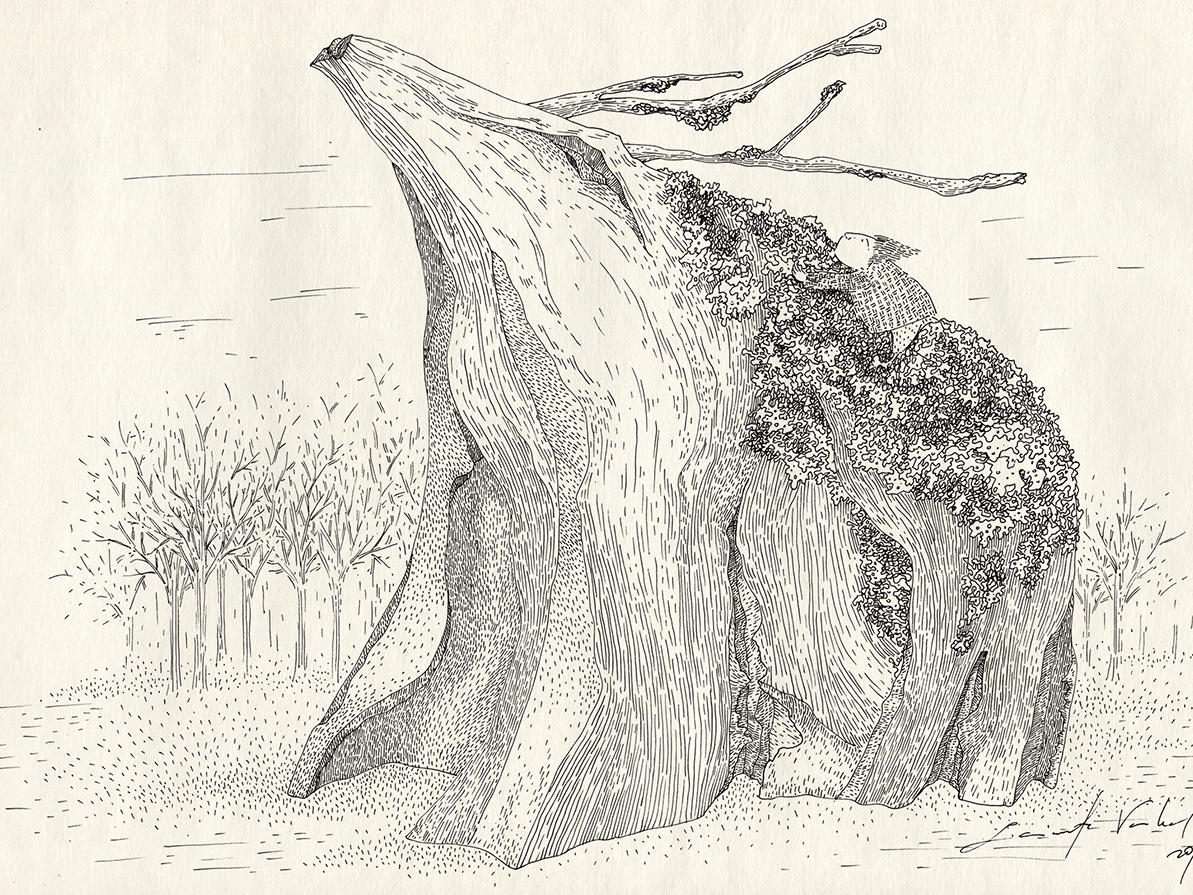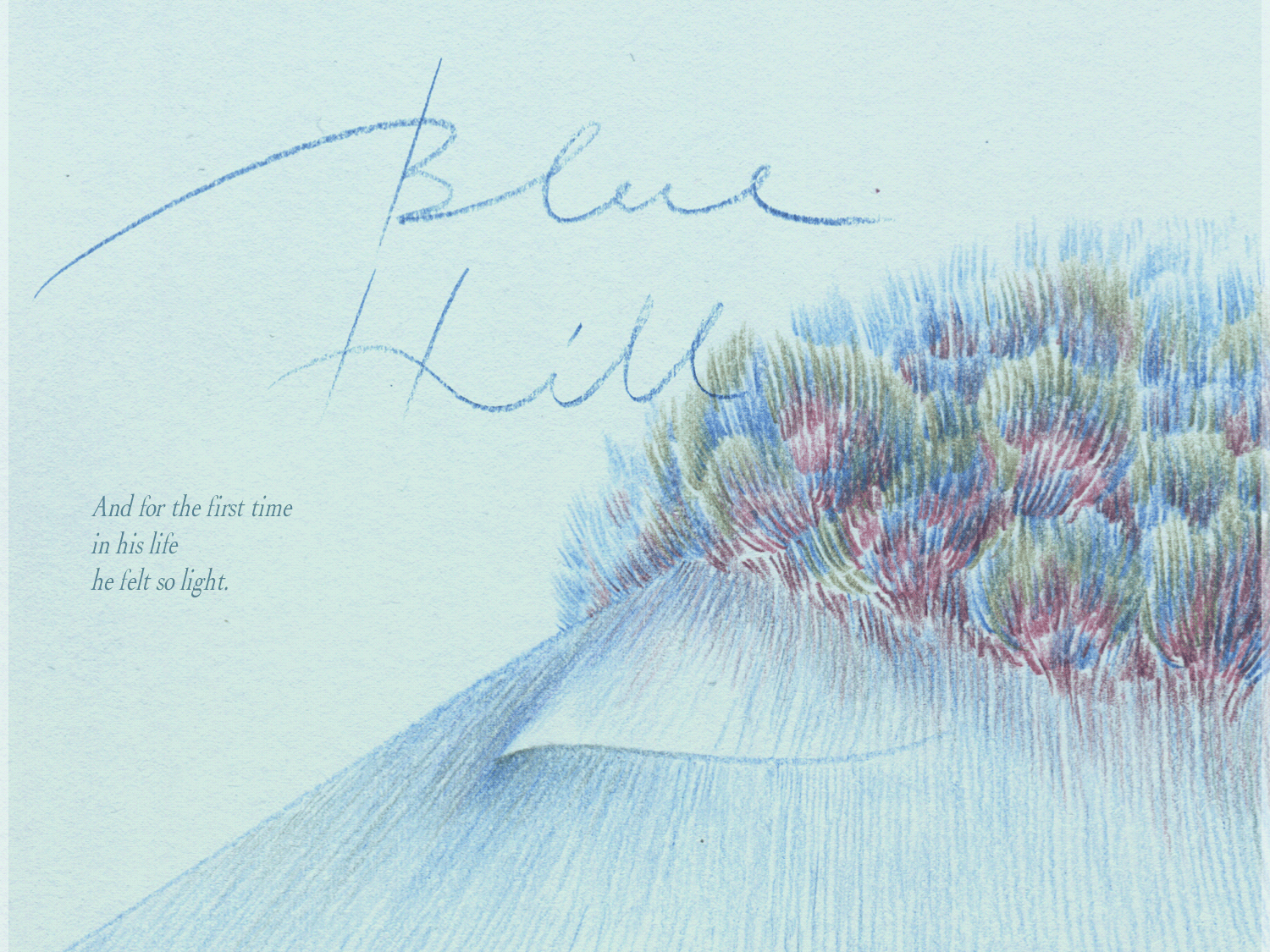Saulės spalvų poringės.
GELTONA
2019-ųjų metų saulėtą rugpjūčio 23 dieną, kai visa Lietuva minėjo Baltijos kelio 30-etį, šis tas šviesaus ir ilgai laukto įvyko ir Rumšiškių kultūros centro Mažojoje salėje. Tos dienos vakaras buvo skirtas pirmajam knygos, kurios žodis ir jį iliustruojantis vaizdas keliavo iki skaitytojo penkerius metus — nuo 2014-ųjų vasario iki 2019-ųjų vasaros, pristatymui. Įdomu yra tai, kad nežinia, ar tai toks savaiminis sutapimas, ar pačios saulės sumanymas prisiliesti prie kiekvieno knygos puslapio, tačiau kaskart, kai tekstinė mintis pradėdavo įgauti piešinio pavidalą, pro mažo kambarėlio-kūrybinės buveinės pietinius langus liedavosi spinduliai, jų šviesa ir šiluma. Ir aš, šios knygos dailininkė, Laimutė Varkalaitė, manydavau, kad tai ne šiaip sau. Tikriausiai saulė jautė, kad knyga, kur kiekvienas žodis ir jį pasitinkanti linija bei spalva, yra skirta ne kam kitam, o jai ir (kaip ji pati) šviesą skleidžiančiam žmogui.
SAULĖS SPALVŲ PORINGĖS yra išskirtinė rašytojos Liudos Petkevičiūtės, daugiau kaip 200 knygų vaikams autorės, knygų serija, sumanyta jau prieš kelis dešimtmečius ir kantriai laukusi savojo dailininko. Esu dėkinga lemčiai, jos vingį kūrusiems žmonėms ir aplinkybėms, jog tenka prisiliesti prie šio kilnaus autorės sumanymo, vaizdu paversti jos mintis, piešiniu priartinti kalbą prie mažojo skaitytojo.
PORINGĖS — tai gausiai iliustruotos ir žodžiais apipintos knygos vaikams bei visai šeimai, jaukiai suburiančios ir įtraukiančios. Šių knygų tikslas — vaizdžiai atskleisti lietuvių kalbos grožį per spalvą, gaivinti jos turtingą žodyną, priminti ir atminti, kaip kalbėjo mūsų ankstesnės kartos, puoselėti ir skatinti didžiuotis savo kalba.
GELTONA PORINGĖ — antroji knygų serijos knyga (pirmoji buvo RAUDONA), kurią sudaro dvi dalys (po 160 puslapių). Kiekviena dalis pradedama dosniu autorės žodžiu, įvedančiu į geltonos spalvos pasaulį, kruopščiai surinktą ir nupintą iš aibės sinonimų, įvairių geltonimų . Puslapis po puslapio, žodis po žodžio, piešinys po piešinio — ir skaitytojas jau keliauja kartu su basakojais besišypsančių akių veikėjais per pienių pievas, atsispiria ir kyla su geltonsparniais geltonpilviais paukščiais į vaiskų dangų, kur groja dūdele su saule, o jai pritaria vėjai-pūtėjai ir visi dangaus skraiduoliai. Antai — net Perkūnas nurimęs. Skaičiuoja žvaigždeles ir gėrisi, kokia graži mūsų lietuvių kalba, išaudusi gintarais pabirusią Jūratės ir Kastyčio legendą, pamokančią Krakio Geltonakio istoriją, geltonpilvės Volungės sakmę, išmoningas mįsles, palyginimus, posakius ir visą apstą neregėtų ir negirdėtų kadais iš lūpų į lūpas skrajojusių žodžių.
Spalva-žodis-piešinys — susitinka kiekviename dviejų dalių knygos puslapyje. Per spalvą pažįstame kalbą, per kalbą — pamatome vaizdą, o vaizdas — žodį kaip auksaspalvį grūdą pasėja mumyse ir palieka minty bei širdy.
GELTONA PORINGĖ yra pagrindinė saulės šviesą nešanti leidinių serijos knyga. Joje kiekvienas surinktas, išgirstas, užrašytas žodis ir grafito linijos piešiniu gimstantis vaizdas — išjausti, išgyventi tam, kad paliestų skaitytoją — mažą ir didelį, mylintį ar dar tik pamilstantį lietuvių kalbą.
Pirmojo šios knygos pristatymo metu Rumšiškėse buvo smagu matyti švytinčius susirinkusiųjų į renginį veidus, jų nustebusias džiaugsmingas akis vartant knygos puslapius ir priglaudžiant ją prie krūtinės kaip žmogų. Ir nėra didesnio džiaugsmo autorei ir man, kai ši saulės šviesą ir šilumą nešanti knyga paliečia skaitytojo rankas, akis ir širdį, palieka ilgam jo atminty ir lūpose, prisijaukinama ir sava, kaip neatsiejama jo paties dalis.
Už tai, kad Liudos Petkevičiūtės žodis ir mano sukurtas vaizdas pavirto šiuo didžiu džiaugsmu, kuriuo dalinamės su visais, mažais ir dideliais knygos mylėtojais, dėkojame leidyklai „Lieparas“, už gerą žodį, patarimus ir palaikymą — spaudos subtilybių žinovui, spaustuvės „Taurapolis“ vadovui Laimui Navikui, už kokybišką puslapių spalvingumą —spaustuvei „BALTOprint“, už penkerių metų laukimą, ramstį mintimi ir žodžiu ačiū sakome savo šeimoms ir artimiesiems, geriems mūsų krašto žmonėms, kurie dosniai dalinasi mintimis apie knygas, lietuvišką žodį ir poringes — Kęstučiui Ežerskiui (Vilniaus Gedimino technikos universiteto dėstytojui) , Romai Blėkienei (leidyklos „Debesų ganyklos“ projektų vadovei) ir kiekvienam iš jūsų, kurie domėjotės poringių keliu, jų gimimu ir kelione iki jūsų. AČIŪ!
Už jaukų priėmimą ir galimybę susimatyti su knygą branginančiais ačiū Rumšiškių kultūros centro direktorei Gražinai Kazanavičienei.
Dėkojame visiems, atėjusiems bei patyrusiems spalvingo piešinio nuotykį ir lietuviško žodžio atradimą.
APDOVANOJIMAI ir ĮVERTINIMAI:
- fondo ŠVIESKIME VAIKUS diplomas ir premija už gražiausias iliustracijas, 2015
- Tarptautinio iliustruotų knygų konkurso „1st Little Hakka international picture book competition“ (Kinija) dalyvė. Konkursui pateiktos trys iliustracijos pateko į antrąjį etapą, 2017
- Tarptautinio iliustracijų konkurso „iJUNGLE Illustration Awards 2019“ (Kinija) laureatė. Konkursui pateiktos Volungės sakmės iliustracijos pateko tarp 83 geriausių darbų iš daugiau nei 1100 kūrinių ir buvo įvertintos tarp 14 BOOK kategorijoje bei pasirinktos konkurso sklaidai soc. tinkluose, 2019-2020
- Tarptautinio iliustruotų knygų konkurso „3rd Little Hakka international picture book competition“ (Kinija) laureatė. Konkursui pateiktos iliustracijos pateko į finalą (tarp 245 iš 1854 darbų, profesionalių publikuotų darbų kategorija (tarp117)), 2019
Aut. Liuda Petkevičiūtė
Iliustr. ir diz. Laimutė Varkalaitė
Leidykla „Lieparas“
Spaustuvė „BALTOprint“
Formatas 206x289 mm
Puslapių sk. 160 p.
Kietas įrišimas
-----------------------------------------
Tales of the Sun.
YELLOW
TALES OF THE SUN (SAULĖS SPALVŲ PORINGĖS) — is richly illustrated and braided by words books for children and family. The aim is to reveal visually the beauty of the Lithuanian language, revive its rich dictionary, remind, how our previous generations used it, cherish and be proud of the native language.
The Lithuanian language is one of the oldest one in the world. Why because it is important not only to use it, but also to remember how it was used time ago and to do it again from early childhood.
The author Liuda Petkevičiūtė uses an original way, how to select the words choosing the color.
TALES OF THE SUN. YELLOW (SAULĖS SPALVŲ PORINGĖS. GELTONA) — is the second and the main book of this series of books, which is composed of two parts (160 pages of each). That is an extraordinary structure book, created more than five years (2014–2019).
In the beginning of books an author introduces to the world of the yellow color. Page after page, word after word, illustration after illustration — and the reader is already walking together with barefoot smiling eyes characters through dandelion meadows, rising with yellow-wings birds, playing with fife with the Sun, winds and all flyers. Even Perkūnas (a god of the Lithuanian mythology) is counting stars calmly and admires what the beautiful Lithuanian language is: a legend of two lovers Jūratė and Kastytis, a story about Krakis Geltonakis (the Lithuanian dragon with yellow big eyes), a saga about the yellow-stomach bird Volungė, many of riddles, comparisons, sayings, words, their synonymous.
In order to reveal a warm feeling of illustrations, there was combined traditional and digital graphic techniques. Firstly — a hand drawn line using a graphite pencil on paper; later — a coloring process made by digital media. Many pictographical details make a great visual adventure for the reader, finding heroes and their surroundings step by step, without any rush and with an interest.
Also, this book could be called an illustrated dictionary of the Lithuanian language, because of its content, a vast range of words and their aim to be seen, heard and pronounced.
In this way a book becomes a timeless object, which has its value and it grows with a time even more.
Yellow-word-illustration — meet in every page of the books. Through the color we are getting know the language, through the language — see the image, ant at last — the image seeds the word as a grain in our mind and heart.
It was an honor for me, Laimutė Varkaklaitė, illustrator and graphic designer of this book, to be a part of this noble mission, rising a beauty of our language through the image dedicated for small readers. And the biggest happiness is to see, how this book achieves hands, eyes and hard of the reader.
The first presentation of this meaningful book was held on August 23, 2019.
Big and warm thanks for all good people and everything around what let to realize an idea of the book.
AWARDS and APPRECIATIONS:
- A diploma and a premium for the nicest children book illustrations, fund 'ŠVIESKIME VAIKUS', 2015 (Lithuania)
- A participant and one of the finalists of the first round in international illustration contest '1st Little Hakka international picture book competition', 2017 (China)
- A participant one of the finalists of international illustration contest 'iJUNGLE Illustration Awards 2019', Merit Award, BOOK category. Also, illustrations were selected to promote the competition in a social media. 2019-2020 (China)
- A participant and one of the finalists of the first round in international illustration contest '3rd Little Hakka international picture book competition', 2019 (China)
Author Liuda Petkeviciute
Ilustrator and graphic designer Laimute Varkalaite
Publishing house ‘Lieparas’
Printing house by ‘BALTOprint’
Format 206x289 mm
Amout of pages 160 p.
Hardcover
___________________
This book of two parts is one of the most meaningful project in my creative way.
I am thankful for an author Liuda Petkevičiūtė and for everyone, who waited for this book for so long.
An here it is!
Both covers of two-parts book in front of You!
An illustration for children book was my biggest dream and I tried to achieve that taking every chance in my life.
And know I have no words to describe how much I am happy to present for You this book.
But wait a bit and, please,
take a look look,
how this detailed book has been created.
A PROCESS.
I
In the very beginning were drawn many of small sketches of compositions according to the author's text.
Also, that was a great way to see the whole book, its page after page and to create a dynamic visual narrative.
Even in these small sketches various emotions and features of characters could be seen very well. Some of these drawings were made as analysis of some objects, how they look in reality and later transformed in a particular graphic style.
This step of the process is very meaningful for the final result.
A PROCESS.
II
Later after making small schemes of pages, drawings were made.
Paper, graphic pencil and an idea which little by little appears inf front of eyes.
This step of the process is full of graphical adventures: characters, textures, unexpected angles of the view, very small details.
A PROCESS.
III
Finally, after preparing linear drawings, finalized using Adobe Photoshop: filled by colors and textures.
And now it is time to present the book!
_____________________
TALES OF THE SUN. YELLOW
Part I
There are four chapters in each part of the book.
The first part begins with a short poem dedicated for the Sun.
The second chapter reveals even more yellow colored things and words about them.
An unique part of this chapter is a tale of Volungė.
Volungė is a small bird which has a yellow tummy and in my country is called a prophet of the rain.
All the pages of this tale is in brown tone and filled by many yelow shades.
The third chapter tells a love story of Jūratė and Kastytis, a tale of Sun dogs, and some useful things about the food:)
Even more Sun You can find in the fourth chapter of the first part of the book.
TALES OF THE SUN. YELLOW
Part II
Riddles — there are many of them in the first chapter of this part of the book, which are illustrated as one narrative and was one of the biggest challenge for me. Why because that is on of my beloved part of the book.
The second chapter is dedicated for a unique character — Krakis Geltonakis — and his story.
Krakis is the Lithuanian dragon.
The story is about a will and how the dragon learned to fly again.
The third chapter — a short Yellow tale about duck and hen.
This story is about how much the word could mean in a context of good relationship.
The last chapter is a vast gallery of characters.
There are more than 140 characters or their positions: ducks, antins, hens, cocks and their children.
I remember very well one summer dedicated for their realization.
And finally — the book in hands!
Some pages from the first book.
Some pages from the second book.
Some details closer.
Many of textures, combinations of colors and methods of coloring —
that was a great adventure for me, indeed.
After publishing the book, there were created some posts in order to spread a message about the book: a beauty of the Lithuanian language, its importance for our native people now and in a future.
A yellow flower made from paper is a symbol of the book and is given to every reader.
Some photos from five presentations of the book:
an author Liuda Petkevičiūtė, me and a lot of shining people.
Thanks for everyone a lot!
Thanks for watching this project!










